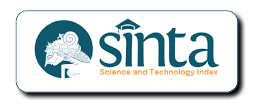Author Guidelines
GUIDELINES FOR AUTHORS
Prospective authors are required to follow the instructions for writing articles in Wahana Sekolah Dasar.
1. Manuscript shall be formatted in one column using 11 pt Times New Roman font type, 1.5 space in the A4 paper, justify alignment in a maximum number of 16 pages. All manuscripts should be in Microsoft Word at least 2010 version.
2. The title should be accurate, unambiguous, specific, and complete. Do not contain infrequently-used abbreviations. The title must be written in title case and should be in 16 pt font size, center alignment, and maximum 20 words.
4. Author’s name shall be in 11 pts font size, centered alignment, and without an academic degree.
5. Correspondence’s address includes an email address, name, and address of correspondence’s affiliation or institution origin written in 10 pt font size and centered alignment.
6. The abstract should be written in both English and Indonesian in one paragraph consists of maximum 250 words. The abstract should explain the purpose, method, and the result of the research concisely. An abstract should stand alone, means that no citation in the abstract.
7. Keywords are any terms related to the general issue(s) of the articles and written minimum 3 keywords, maximum 5 keywords, separated by semicolon (;)
8. Systematic for research article (IMRAD) are:
- Introduction is a part consists of a background of the study, literature review as a basis of the research issue, hypotheses, and the purpose of the study. This part shall be presented in the form of the paragraph and with no title part.
- Method is a part consists of the design of the research, subject, instrument, data collection procedure, and data analysis
- The part of result exposes the findings obtained from research data which is related to the hypotheses. The results should summarize (scientific) findings rather than providing data in great detail.
- The part of discussion explains the findings obtained from research data along with theory and similar research comparison. Make the discussion corresponding to the results, but do not reiterate the results. The following components should be covered in discussion: How do your results relate to the original question or objectives outlined in the Introduction section (what/how)? Do you provide interpretation scientifically for each of your results or findings presented (why)? Are your results consistent with what other investigators have reported (what else)? Or are there any differences?
- Conclusion part answers the aforementioned hypotheses, research purpose, findings, and discussion as well as the expected suggestions for the future research. Conclusion shall be written in a paragraph. Do not repeat the Abstract, or just list experimental results.
- Acknowledgment (Optional) Recognize those who helped in the research, especially funding supporter of your research. Include individuals who have assisted you in your study: Advisors, Financial supporters, or may another supporter, i.e. Proofreaders, Typists, and Suppliers, who may have given materials. Do not acknowledge one of the authors names.
- Reference, all the references that used in the article must be listed in this part. In this part, all the used references must be taken from primary sources (scientific journals at least 80%from all the references) that published in the last ten years. Cite the main scientific publications on which your work is based. Citations of textbooks should be used very rarely and citations to web pages should be avoided. Avoid excessive self‐citations. Each article should has at least 15 references.
9. Systematic for review article are: title; author’s name; correspondence address, abstract, keywords, introduction (no title); main discussion (could be divided into several sub-discussion); conclusion; acknowledgment (optional); references (should has at least 25 references).
10. Each title part shall be written in different types (all title part and subpart shall be written in bold or italic bold) and not in numbering format:
- HEADING 1 (CAPITALIZED ALL FONT, BOLD, LEFT-ALIGNMENT, 11 pts)
- Heading 2 (Title case, bold, left-alignment, 11 pts)
- Heading 3 (Title case, italic bold, left-alignment, 11 pts)
11. Table: table shall be clearly identified using number and title above the table in bold font, 11 pt font, left alignment. The table shall be positioned in left-right alignment. The first letter in the table shall be capitalized, except phrases. Table’s data shall be written in single space, 10 pt font. The table shall be presented only in horizontal line and shall be mentioned in the paragraph.
12. Figure: Figure shall be presented in average to high resolution and identified using number and title above the table and written in bold font 11pt left alignment. Figure shall be mentioned in the paragraph.
13. Citation and Reference are written according to the APA (American Psychological Association) 6th edition style. The references shall be ordered based on alphabetical and chronological order. We recommend to use reference manager application such as Mendeley, End Note, or Zotero. Below are the example ofReferences written according to the APA 6th edition style.
- Waseso, M.G (2001). Isi dan Format Jurnal Ilmiah. Jakarta: Ghalia Indonesia.→Book
- Saukah, A. & Waseso, M.G (2002). Menulis Artikel untuk Jurnal Ilmiah. Malang: UM Press.→Book
- Maher, B. A. (Ed.). (1964–1972). Progress in Experimental Personality Research (6 vols.). New York: Academic Press.→Book with editor(s)
- Luria, A. R. (1969). The mind of a mnemonist (L. Solotaroff, Trans.). New York: Avon Books. (Original work published 1965)→Book : A Translation (writer: Luria, A. R., translator: L. Solotaroff)
- Hitchcock, S., Carr, L. & Hall, W. (1996). A Survey of STM Online Journals, 1990-1995: The Calm before the Storm, 1(4), 132-141. Retrieved from http://journal.ecs.soton.ac.uk/survey/survey.html→Journal (online)
- Shelly, D. R. (2010). Periodic, chaotic, and doubled earthquake recurrence intervals on the deep San Andreas fault. Science, 328(5984), 1385-1388.→journal (print)
- Wilkinson, R. (1999). Sociology as a marketing feast. In M. Collis, L. Munro, & S. Russell (Eds.), Sociology for the New Millennium. Paper presented at The Australian Sociological Association, Monash University, Melbourne, 7-10 December (pp. 281-289). Churchill: Celts.→Proceeding
- Makmara. T. (2009). Tuturan persuasif wiraniaga dalam Berbahasa Indonesia: Kajian etnografi komunikasi. (Unpublished master’s thesis) Universitas Negeri Malang, Malang, Indonesia.→Thesis
- United Arab Emirates architecture. (n.d.). Retrieved June 17, 2010, from UAE Interact website: http://www.uaeinteract.com/→Website (not preferable)
- Menteri Perhubungan Republik Indonesia. (1992). Tiga Undang-Undang: Perkeretaapian, Lalu Lintas, dan Angkutan Jalan Penerbangan Tahun 1992. Jakarta. CV. Eko Jaya. →Goverment publication
14. All issues regarding permission of citation or software utilization during the process of paper or any issues regarding Intellectual Property Rights related to the author including its legal consequences will be the responsible of the author.
15. The Board is authorized make a necessary changes or adjustment related with language properties without altering the substance. Substance editing would be consulted with the author first.
16. Manuscript shall be submitted online via journal website on journal2.um.ac.id/index.php/wsd. If you encountered any difficulties, contact us thru wsekolahdasar@gmail.com











